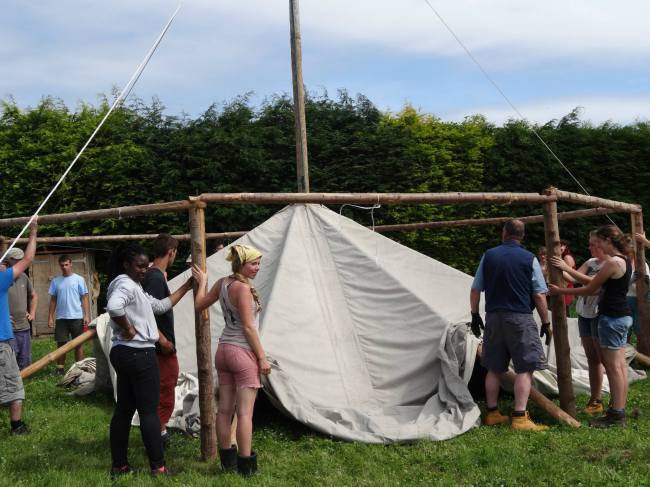Here’s a small taste of our set-up process, lovingly described by one of this year’s new volunteers, Rosie. She was also kind enough to write us a beautiful poem, which I feel truly captures what it’s like waking up on site each morning.
Arriving at G&A the day before setup I found a small kitchen tent, two caravans and an otherwise empty field; it seemed lost in the Worcestershire countryside. Now just over a week into set up and the village green is ringed with tents, marquees, domes and of course the yurt (not that I had ever put up a yurt before). But more than that, the people who have arrived since then have transformed the site. From the amazing interns and ever-working trustees already in residence, to the influx of volunteers all with their own inspirations and stories to tell, G&A has become a vibrant and exciting community. I have learnt so much, tried new foods and even participated in my first hen night (best wishes to you both for all the years to come). I have also made friends that it feels like I have known for much longer – it’s hard to believe that a group can become so tight-knit in just a few days. There is so much variation in where we have come from – which is so much more than birthplace or nationality – and what we have done before, however, none of that matters at here as long as you’re willing to give it a go. Don’t misunderstand, it is hard work and serious too. Just like any service provider Green and Away has a deadline to meet. We have to be ready to host conferences and provide all the facilities expected of us.
There is a routine and a rhythm that the site breathes by, that captures a sense of belonging and acceptance that is often lacking in the world at large. Working with the environment to get the best out of both people and nature, okay, so it may sound a little hippie-ish but I assure you it’s not, its common sense, sustainable and more importantly it works year on year.
Morning
In and out,
breathing.
The rhythm of the site,
other people, the plants,
living all around.
The rising sun mourning the loss
of the diamonds in the grass.
Which it sees but
for the briefest glimpse.
Then gone in the growing light.
Rejoicing, after, in the songs
soaring from the birds.
Echos of their wings
flitting between tent and tree
awash in new beginnings.
Stirrings, soon to emerge,
the steam off boiling water,
the feel of bread dough
beneath the hands,
the calls of morning greetings.












